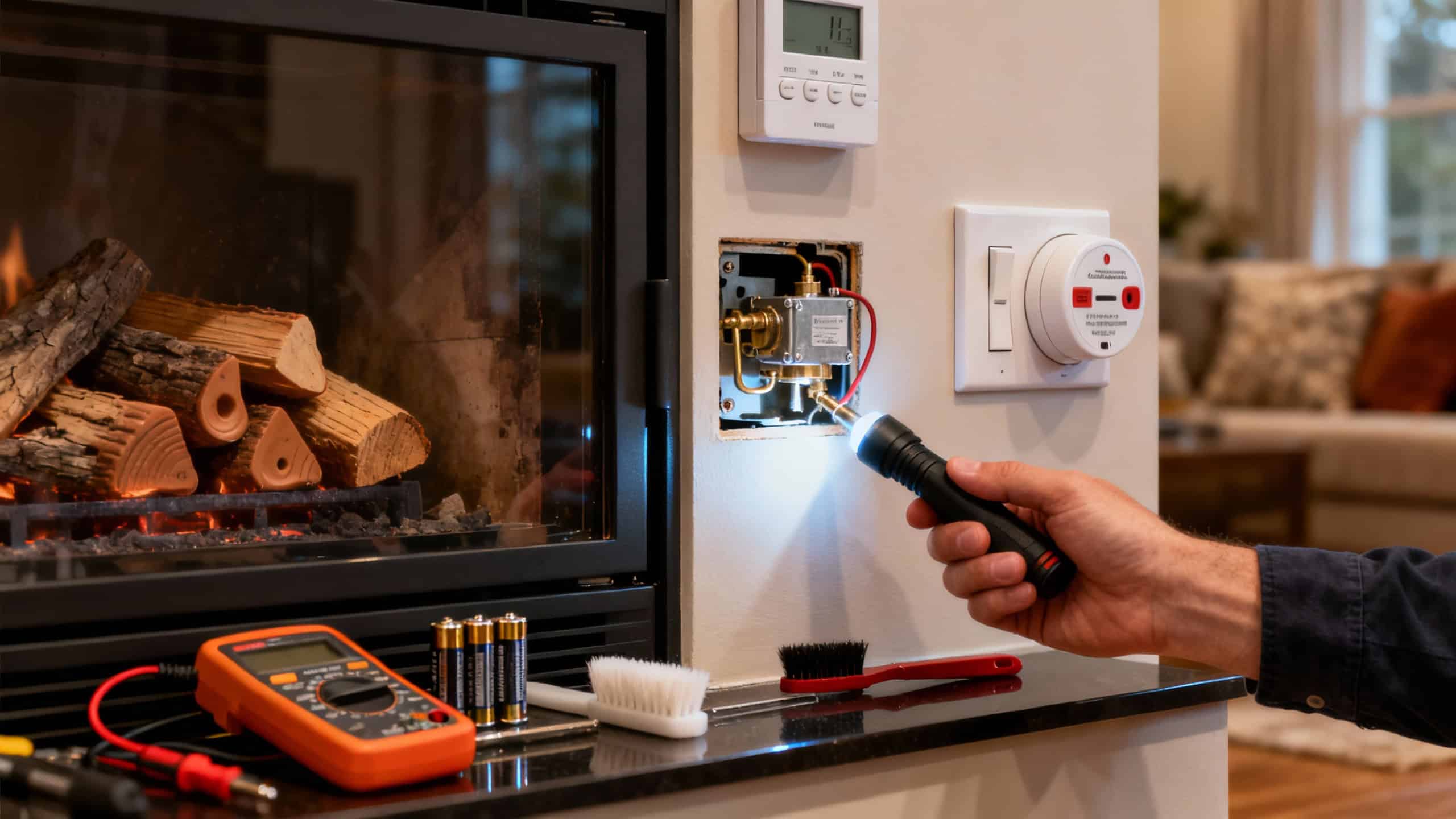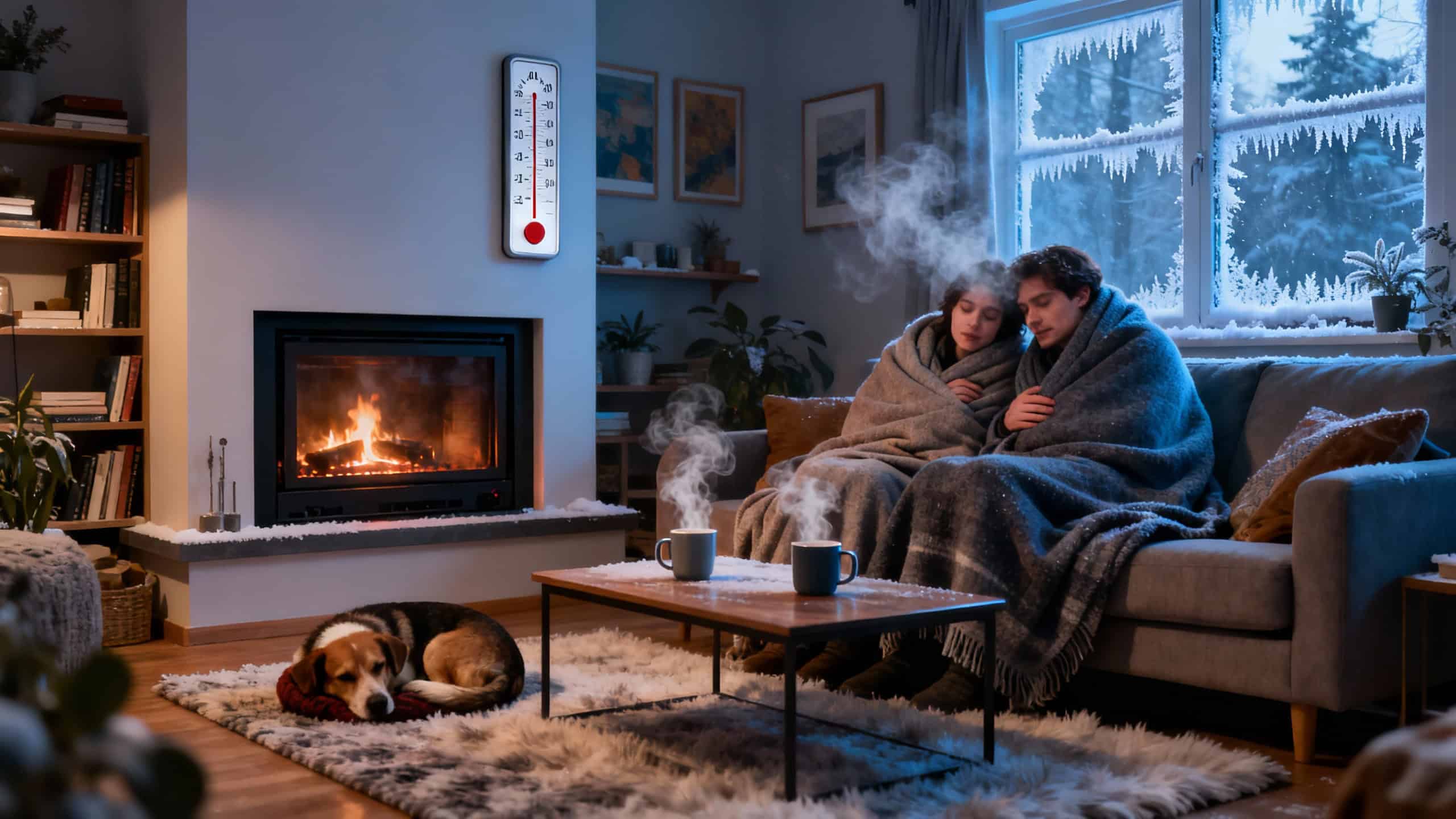A gas fireplace that clicks but won’t light usually means the igniter is working but gas isn’t reaching the burner.
The pilot light may be out, the gas valve could be closed, or debris might be blocking the gas flow. Check that the manual shutoff valve is open and the pilot light is lit.
If the pilot won’t stay lit, a faulty thermocouple or thermopile may be preventing gas from flowing properly. For safety concerns or persistent issues, this guide covers troubleshooting steps and when professional help becomes necessary.
Key Highlights
- Clicking indicates the igniter is working, but no flame means the pilot light is out or gas isn’t reaching the burner.
- Check if the manual gas shutoff valve is fully open, as it may have been accidentally closed during maintenance.
- A faulty thermocouple or thermopile may prevent gas flow even when the igniter sparks, requiring professional replacement.
- Dirty pilot orifice or burner debris can block gas flow, preventing ignition despite successful clicking sounds.
- If the pilot won’t stay lit after relighting, contact a TSSA-licensed technician to diagnose and repair safely.
Why Your Gas Fireplace May Not Be Working
When a gas fireplace refuses to start, the problem usually stems from one of several common mechanical or operational issues.
The pilot light may have gone out due to a draft or gas interruption, or critical components like the thermocouple or thermopile might have failed and need replacement.
Other culprits include blocked gas supply lines, dead batteries in the remote control, or dirt and debris obstructing the burner assembly.
Pilot Light Is Out
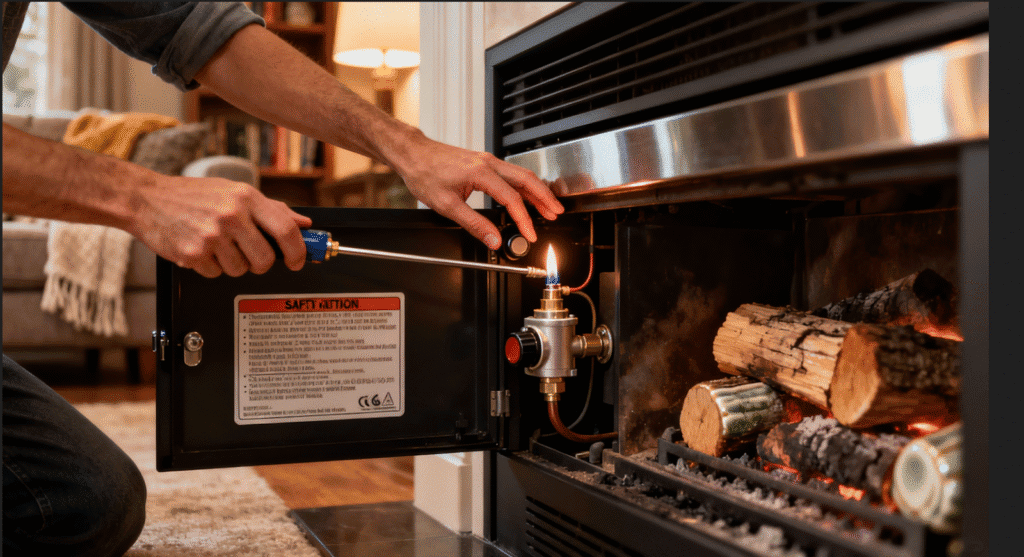
The most common reason a gas fireplace won’t start is that the pilot light has gone out.
When this happens, there’s no flame to ignite the main burner, even if you hear clicking sounds.
When your pilot light won’t stay lit, it’s often due to a blocked pilot orifice, a faulty thermocouple, or gas pressure irregularities.
Cleaning the pilot assembly and checking for airflow disturbances can resolve many of these issues before they require professional servicing.
If your gas fireplace pilot light won’t stay lit, several issues could be at fault:
- Draft Or Air Flow blowing out the flame from nearby vents or chimneys
- Dirty Pilot Orifice blocking proper gas flow to maintain a steady flame
- Thermocouple Malfunction failing to sense heat and shutting off gas supply
Check if the pilot is visible through the viewing glass before attempting any repairs.
Faulty Thermocouple or Thermopile
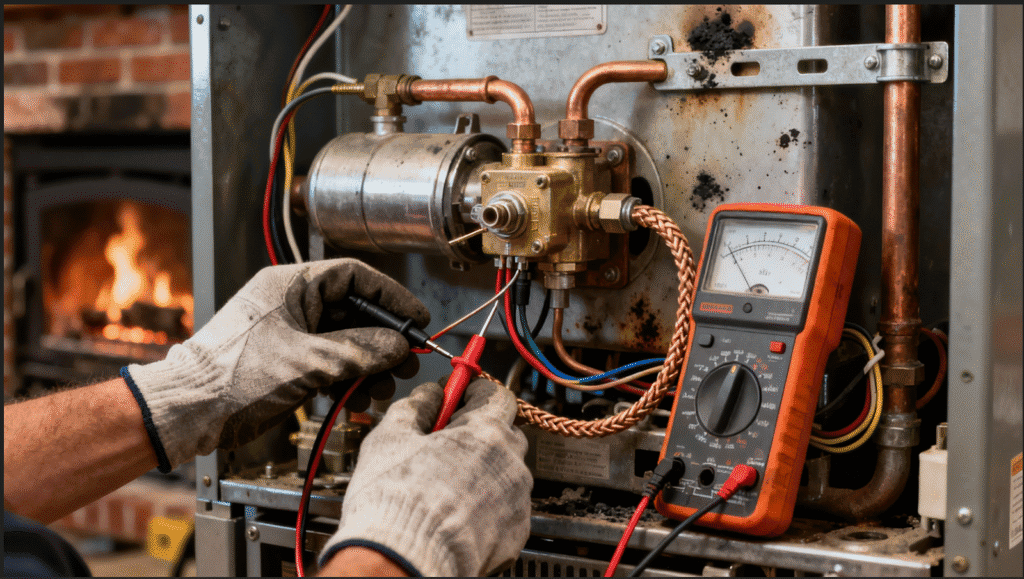
A faulty thermocouple or thermopile ranks among the top reasons a gas fireplace pilot light won’t stay lit, even after successful ignition.
These safety components measure flame heat and signal the gas valve to remain open. When they fail, the valve closes automatically, cutting off gas flow.
A thermocouple typically costs $20-$50 to replace, while thermopiles run $50-$150.
Common gas fireplace ignition problems include weak electrical output from aging sensors or dirt buildup blocking proper heat detection.
Testing requires a multimeter to check voltage output, and replacement demands technical expertise to ensure safe, code-compliant installation.
Dust buildup and weak electrical connections can prevent proper sparking. Homeowners can try gentle cleaning and checking the gas valve, but deeper electrical or gas-related issues should be handled by a professional.
If your gas fireplace fails to ignite, the cause could be a weak spark igniter, a faulty thermocouple, or low gas flow.
These ignition-related problems are common after long periods of disuse, and understanding how to diagnose them safely helps homeowners know when professional repair is needed.
Gas Supply Issues
Gas supply disruptions account for approximately 15-20% of all fireplace malfunction calls, ranging from simple valve closures to complex pressure regulation failures.
When your gas fireplace is not lighting, check if someone accidentally turned off the main gas valve. Low gas pressure from your utility company can also prevent ignition.
Common gas supply problems include:
- Closed Manual Shutoff Valve near the fireplace that was turned off during cleaning
- Empty Propane Tank if your home uses LP gas instead of natural gas
- Gas Line Blockages from debris or sediment buildup reducing flow
Verify your gas stove works to confirm house-wide supply.
Homeowners often face common gas fireplace problems, especially after long periods of disuse. From faulty thermocouples to clogged pilot assemblies, these issues can prevent proper ignition or cause the flame to go out unexpectedly.
Power or Battery Problems
Many modern gas fireplaces rely on electrical power or batteries to operate their electronic ignition systems, remote controls, and blower fans.
When batteries run low or die completely, the fireplace won’t respond to commands or ignite properly. Check the battery compartment in your remote control or receiver box and replace old batteries with fresh ones.
If your unit plugs into an outlet, verify the cord is securely connected and the circuit breaker hasn’t tripped.
Power disruptions prevent the ignition sequence from completing, which is when professional gas fireplace repair becomes necessary to diagnose electrical component failures.
Dirty Burner or Obstructed Components
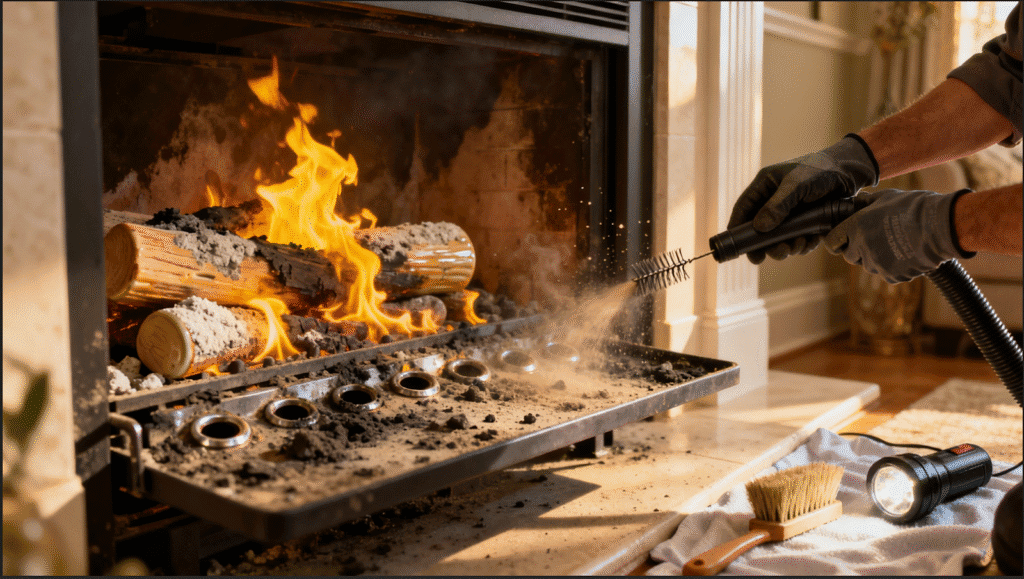
Over time, dust and debris accumulate inside the fireplace and settle on critical components like the burner ports, pilot assembly, and flame sensor.
When these parts get dirty, the fireplace may click but fail to ignite properly. Carbon buildup restricts gas flow through the burner ports, preventing consistent flames.
Common Signs Include:
- Weak or uneven flames that don’t spread across the entire burner
- Delayed ignition after multiple clicking attempts
- Visible soot or debris around the pilot area
Professional gas fireplace repair includes thorough cleaning to restore safe, efficient operation and prevent future malfunctions.
Troubleshooting Steps You Can Try at Home
Before calling a technician, homeowners can perform several basic checks that often resolve common gas fireplace problems.
These troubleshooting steps require no special tools and take only a few minutes to complete.
Starting with the simplest fixes first can save time and potentially avoid an unnecessary service call.
Check the Pilot and Gas Valve
The first step in diagnosing a gas fireplace that won’t start is to locate and inspect the pilot light assembly. Look through the glass or open the front panel to see if a small flame is visible. If there’s no flame, the pilot needs to be relit following the manufacturer’s instructions.
Before attempting any gas fireplace repair, consider these important safety points:
- Turn off the gas supply and wait five minutes before relighting
- Never use matches near leaking gas odors
- Call a professional if unsure about any procedure
Check that the gas valve is fully open. If you’re unsure what steps to take when their gas fireplace refuses to start or stay lit, expert advice from technicians and other homeowners can help you troubleshoot the problem safely and efficiently.
Test the Remote or Wall Switch
Sometimes a gas fireplace won’t turn on simply because the remote control has dead batteries or the wall switch has lost its connection. Homeowners should first replace the remote batteries with fresh ones and test the fireplace again. If using a wall switch, check that all wires are securely connected and the switch clicks properly when pressed.
| Component | Troubleshooting Step |
|---|---|
| Remote Control | Replace batteries and test signal |
| Wall Switch | Verify wiring connections |
| Both Systems | Check for visible damage or corrosion |
When these simple fixes don’t work, professional gas fireplace repair becomes necessary.
Clean the Fireplace Glass and Burner Area
Over time, dust and soot can accumulate on gas fireplace components and significantly reduce performance or block sensors. Regular cleaning prevents many common gas fireplace repair issues. Homeowners can safely clean exterior surfaces when the unit is completely cool and the gas valve is off.
- Wipe The Glass Door with appropriate cleaner to remove film that blocks heat and flame visibility.
- Vacuum Around Burner Ports using a soft brush attachment to clear dust without damaging components.
- Inspect For Debris inside the firebox that could interfere with proper airflow and combustion.
Professional gas fireplace repair technicians can perform deeper cleaning during annual maintenance visits.
Signs It’s Time to Call a Fireplace Repair Expert
While some gas fireplace problems can be fixed with basic troubleshooting, certain situations require professional expertise to ensure safety and proper function.
Homeowners should recognize when DIY efforts aren’t enough and a trained technician needs to step in. Issues like repeated ignition failures, strange sounds coming from the unit, or skipping regular maintenance schedules are clear indicators that professional help is necessary.
If your gas fireplace isn’t working as it should, it’s best to rely on professional gas fireplace repair services from ALP Heating.
Their licensed technicians handle all types of issues—from faulty pilot lights and ignition problems to weak flames and gas leaks.
With same-day service available across the GTA, they ensure your fireplace operates safely, efficiently, and provides steady warmth all winter long.
Persistent Ignition Problems
If a gas fireplace refuses to ignite after multiple attempts, the problem likely extends beyond simple fixes homeowners can handle themselves.
Repeated clicking without lighting often indicates deeper mechanical or electrical failures that require professional diagnosis.
When ignition problems persist despite basic troubleshooting, it’s time to contact certified technicians for gas fireplace repair.
If your fireplace starts but quickly shuts down, the issue may involve sensor faults, overheating protection, or irregular gas flow.
These built-in safety mechanisms prevent hazards but often signal deeper mechanical problems that require a technician’s assessment.
Continuing to attempt ignition can:
- Waste gas and create safety hazards in your home
- Damage expensive components like igniters or control valves
- Leave your family without reliable heat during cold weather
Professional technicians have specialized tools to identify and resolve complex ignition issues safely.
Unusual Noises or Smells
Strange sounds or odors coming from a gas fireplace signal potential safety hazards that demand immediate professional attention.
Hissing noises may indicate a gas leak, requiring immediate ventilation and expert gas fireplace repair.
A rotten egg smell similarly warns of escaping gas, as natural gas is odorized for detection.
Metallic clanging or persistent popping suggests loose components or debris inside the firebox.
Burning plastic smells point to electrical problems that need diagnosis.
Any unusual odor or sound warrants turning off the gas supply immediately and contacting TSSA-licensed technicians who can identify the source and restore safe operation.
When your fireplace struggles to ignite, produces little heat, or shuts off unexpectedly, it’s time to call ALP Heating’s gas fireplace repair experts.
Our certified team quickly diagnoses and fixes ignition, pilot, and airflow issues for all major brands. With prompt service and a focus on safety, ALP Heating ensures your fireplace is restored to full efficiency and ready to keep your home cozy.
Annual Maintenance Is Overdue
Regular maintenance keeps gas fireplaces operating safely and efficiently, yet many homeowners overlook this critical service until problems arise.
Annual inspections catch small issues before they become costly repairs requiring extensive gas fireplace repair. During professional servicing, technicians clean burners, test safety components, and verify proper ventilation.
Skipping maintenance creates risks:
- Carbon Monoxide Buildup from blocked vents threatens your family’s safety
- Higher Energy Bills result from inefficient operation and dirty components
- Expensive Emergency Repairs replace preventable fixes that cost $150-$300 annually
Schedule yearly inspections to avoid unexpected breakdowns during Ontario’s coldest months.
When to choose the Professionals for Gas Fireplace Repair?
Not all HVAC companies have the proper credentials to work on gas appliances, which is why choosing a TSSA-licensed technician is critical for safety and compliance.
Homeowners in Vaughan and the GTA can trust ALP Heating’s certified professionals to diagnose and repair gas fireplace issues quickly, often providing same or next day service for urgent problems.
With over 200 five-star reviews and multiple HomeStars awards, ALP Heating combines technical expertise with reliable customer service that residents can count on during the cold winter months.
ALP Heating is a trusted HVAC company serving homeowners throughout the Greater Toronto Area. They specialize in installation, maintenance, and repair of furnaces, fireplaces, air conditioners, and water heaters. Whether you need emergency service or routine seasonal maintenance, ALP Heating delivers reliable solutions that keep your home comfortable year-round.
Beyond fireplace repairs, ALP Heating offers comprehensive gas line solutions for homes and businesses, including installations for stoves, dryers, water heaters, and outdoor BBQ setups.
TSSA-Licensed Technicians
When dealing with gas fireplace repairs, hiring TSSA-licensed technicians ensures the work meets Ontario’s strict safety standards for gas appliances.
These professionals have the training and certification to diagnose complex issues safely. ALP Heating employs TSSA-licensed experts who understand gas fireplace systems thoroughly.
Choosing licensed professionals provides important benefits:
- Peace Of Mind knowing your family’s safety is prioritized
- Confidence that repairs comply with all provincial regulations
- Assurance that warranties remain valid after professional gas fireplace repair
Licensed technicians identify problems others might miss.
They handle gas connections properly, preventing dangerous leaks or carbon monoxide risks in your home.
Fast, Reliable Service You Can Trust
A broken gas fireplace during Ontario’s cold winter months requires prompt attention to restore comfort and warmth to the home.
ALP Heating offers same or next day service for emergency gas fireplace repair, minimizing downtime when heating is needed most. Their technicians arrive equipped with common replacement parts and diagnostic tools to complete repairs efficiently.
The family-owned business has earned over 200 five-star reviews on Google and HomeStars by consistently delivering reliable solutions. Homeowners across the GTA trust ALP Heating for dependable HVAC care and professional installation services.
From energy-efficient furnaces and air conditioners to reliable fireplace repairs, the company provides top-quality solutions tailored to every home. Their commitment to comfort, safety, and customer satisfaction makes them a go-to choice for year-round heating and cooling needs.
FAQs About Gas Fireplaces That Won’t Start
Homeowners often have similar questions when their gas fireplace refuses to start or stay lit.
Understanding whether a pilot light can be safely relit, how to identify faulty components, and what maintenance schedule to follow helps prevent future problems.
These common concerns address both immediate troubleshooting steps and long-term care for gas fireplaces in the Greater Toronto Area.
Can I relight the pilot light myself if it goes out?
Yes, most homeowners can safely relight their gas fireplace pilot light by following the manufacturer’s instructions printed on a label inside the unit.
The process typically involves turning the gas valve to “pilot,” holding down the control, and using a lighter or igniter button.
However, if the pilot won’t stay lit after multiple attempts, this signals a deeper issue requiring professional gas fireplace repair:
- Faulty Thermocouple Preventing Safe Operation
- Gas Supply Problems Creating Hazardous Conditions
- Valve Malfunctions Requiring Licensed Expertise
Contact TSSA-certified technicians when DIY relighting fails repeatedly.
How do I know if my thermocouple or thermopile is faulty?
When the pilot light refuses to stay lit after multiple attempts, the thermocouple or thermopile is often the culprit behind this frustrating problem.
These components detect heat from the pilot flame and signal the gas valve to remain open. If they fail, the safety system shuts off gas flow automatically.
Signs include a pilot that lights but extinguishes immediately when you release the button.
A multimeter test can measure voltage output, but most homeowners prefer calling professionals for gas fireplace repair.
TSSA-licensed technicians accurately diagnose sensor failures and replace defective parts safely.
Could a power outage affect my gas fireplace operation?
Many modern gas fireplaces depend on electricity to function properly, which means a power outage can prevent them from operating even though they burn gas.
Electric components control ignition systems, blowers, and thermostats in most units.
Here’s what stops working during an outage:
- Electronic Ignition Systems won’t spark to light the pilot or burner
- Blower Fans can’t circulate warm air throughout your room
- Digital Thermostats And Timers lose power and can’t send signals
If your fireplace won’t start after power returns, try resetting the system.
For persistent problems, contact a professional for gas fireplace repair assistance.
How often should a gas fireplace be serviced in Toronto?
Gas fireplace manufacturers and HVAC professionals typically recommend annual servicing to ensure safe and efficient operation throughout the heating season.
Scheduling maintenance before winter helps identify worn components, clean burners, and verify proper ventilation. Toronto homeowners who use their fireplaces regularly should prioritize yearly inspections to prevent mid-season breakdowns.
Professional gas fireplace repair technicians check for gas leaks, test ignition systems, and ensure carbon monoxide detectors function correctly. Annual servicing extends equipment lifespan and maintains warranty coverage.
Homes with older units or heavy usage may benefit from additional mid-season checkups to address wear before problems develop.



